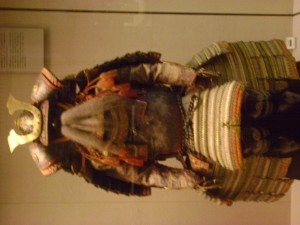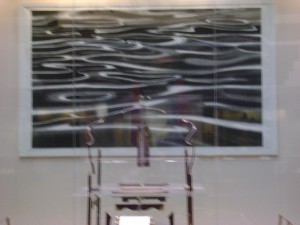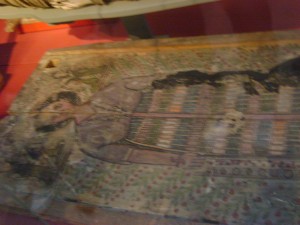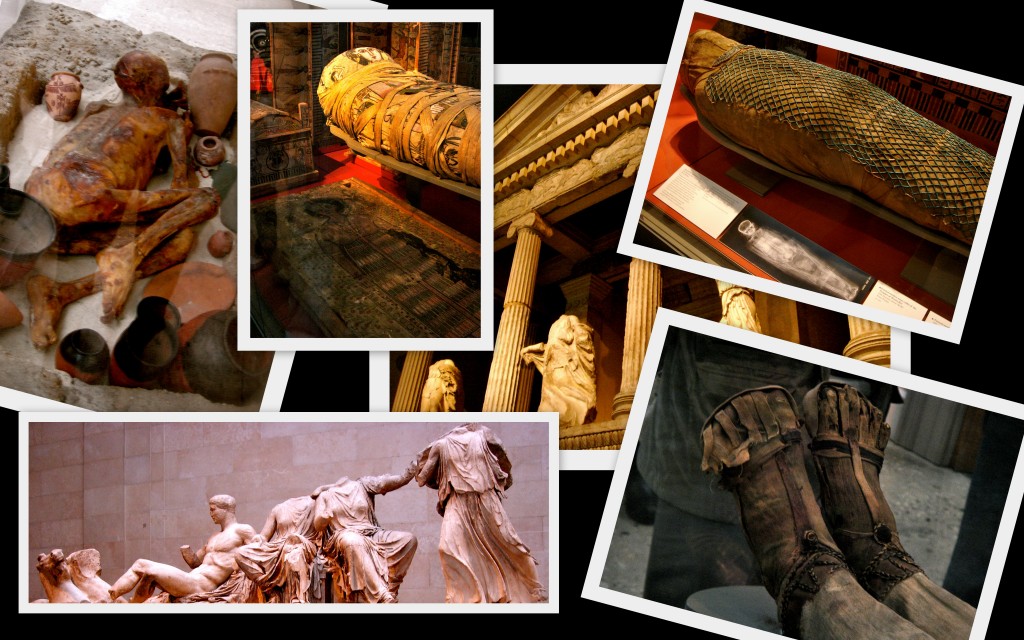September 14th, 2009 · 2 Comments
Yesterday I had a absolutely HORRIBLE experience at the British Museum.
It started off ok, as soon as I entered I got a map and began walking through some of the exhibits. I began my adventure in the Living and Dying Exhibit. I then began to climb up the stairs and headed into the Chinese Ceramics Exhibit. As someone who has practiced throwing pottery for seven years, I have a GREAT respect for ceramic technique and craftsmanship. However, I was not pleased with the woman who had answered her phone in the middle of the exhibit and was having a VERY loud discussion on her mobile. This irked me but what happened next sent me over the edge. After looking at the ceramics I went to the Mummy room. The room was packed with people and screaming children (not that I could blame them because I also felt like screaming). As I began to walk around the room in effort to see the mummies and read the panels next to them people, people were bumping me and pushing me out of the way to take touristy pictures with the sarcophagi. This completely disgusted me; these people have absolutely no respect for museums, the dead, history, nor their fellow museum goers. When my corpse is hundreds of years old I do not want it to be on display for people to take pictures with while they hold their thumbs high in the air. If I were those Egyptian pharaohs, commoners, etc. I would haunt those fools. By the time I left the room I felt as though I was going to have a panic attack: my heart was pounding, my head spinning, I could not focus on anything, and I was beginning to regret the coffee I had right before. The rest of the museum is a bit of a blur, I vaguely remember seeing people leaning on ancient statues. Most of the time I was at the museum I felt as though I was heading against the crowd. The only thing that I distinctly remember after that was almost getting run over by a large group of Asian tourists on my way out the door.
Something needs to be done to the layout and the security of these exhibits to improve the safety of visitors and of the artifacts the museum houses. Photography should not be permitted on the premises and a walking path should be constructed (especially in the Mummy room) to make it smoother and easier for every visitor to see and appreciate the artifacts. The use of mobiles in the museum should be restricted and enforced. There should also be more security protecting the statues and patrolling the area. I would not mind paying an entrance fee to the museum if it meant the museum would change these things.
Tags: Rebecca
September 1st, 2009 · 1 Comment
Since the first day that we arrived at the Arran Hotel, I have been grappling with this concept of time and the need for humans to categorize everything. Humans have become completely reliant on categories, words, titles, definitions, labels etc. It is has been completely imbedded in us to put a title on everything, whether it is clothes, race, gender, sexuality, measurements, concepts, and what I realized today, time. Even time is broken down into different categories, years, months, weeks, days, hours, minutes, seconds and so on and so forth. As I tell you of my endeavors today, and do my best to inform you of my epiphany and how to dissect the concept of time, try to imagine a world where time did not exist, instead think about just being. If that even makes sense.
Today I traveled not only the world, but back in time. I began my day in London as I walked with friends to grab brunch before beginning my adventures. We decided that Subway would be a satisfying and well balanced meal before leaving the country and our present day. We ate a quick bunch because we were eager to see what the rest of the world had to offer. Once our bellies were filled with double turkey and cheese (literally we all had the same thing) we headed out.

 Our machine that would transcend both countries and time was guarded by a huge gate. The name of it was the British Museum and as we entered people of all different ethnicities, and classes were leaving and coming from their own journey’s. The vast time capsule greeted us and as we traveled up the stairs we had already decided our first destination would be Egypt. We passed through time and space at the speed of well, us because the stairs were quite numerous, but once we arrived we were greeted by Egyptian royalty, and mummies. The exhibit was gorgeous and the mummies, plenty, but as I stared at the mummies, I could not get the concept of time out of my head. Dancing in my mind was the fact that at one point these mummies were alive, and now thousands of years later here I am looking at their preserved corpses. I soon was able to focus on the beautiful pieces in front me and tried to push the ideas in my head aside for future analysis. We saw many other exhibits, including one on Japan, and another on North America. Each exhibit shared both the culture and the history of its people. Thinking of the past present and future of the many different cultures of the world quickly brought me back to this concept of time, but for the sake of time, I decided to visit another museum.
Our machine that would transcend both countries and time was guarded by a huge gate. The name of it was the British Museum and as we entered people of all different ethnicities, and classes were leaving and coming from their own journey’s. The vast time capsule greeted us and as we traveled up the stairs we had already decided our first destination would be Egypt. We passed through time and space at the speed of well, us because the stairs were quite numerous, but once we arrived we were greeted by Egyptian royalty, and mummies. The exhibit was gorgeous and the mummies, plenty, but as I stared at the mummies, I could not get the concept of time out of my head. Dancing in my mind was the fact that at one point these mummies were alive, and now thousands of years later here I am looking at their preserved corpses. I soon was able to focus on the beautiful pieces in front me and tried to push the ideas in my head aside for future analysis. We saw many other exhibits, including one on Japan, and another on North America. Each exhibit shared both the culture and the history of its people. Thinking of the past present and future of the many different cultures of the world quickly brought me back to this concept of time, but for the sake of time, I decided to visit another museum.


We headed back to the hotel to pick up a few more “time travelers”. Once we everyone was ready we headed to the tube station. As a topic of conversation one of the students asked what was everyone going to do there next blog about. I shared with them that I was trying to center mine about the concept of time. Then one student shared their idea that “time is a social construction.” Now being an American Studies major I am all too familiar with the concept of social constructions, but for some reason the fact that time was a part of that list was something I never connected with. I continued the rest of our journey to the Victoria and Albert museum trying to dissect this sudden epiphany.
Now of all the museums I have visited since arriving in London the Victoria and Albert museum is by far the most amazing in my opinion. Once departing off the train the group and I walked down a vast tube like path and at the end was an entrance straight into the sculptures section. Immediately I was blown away by the detail that each of the pieces consisted of. Each sculpture portrayed a message or told a story of some sort which struck me, seeing as how before they were created they were nothing but stone. I next made my way through decades of fashion, paintings, and the history of numerous cultures, and with each one I began to appreciate not only their art but their history, their story spanning time for thousands of years.
I learned today how reliant mankind is on time, and the fact that time doesn’t really exist. Before men and women even came up with the concept of time, things just existed, lived and died, were created and destroyed. There was no dependency on time, but now it has been imbedded in our culture as something normal. Thinking about it I love the whole idea of time, but I do find flaws in it as well. The fact that life has become a series of planned and scheduled events disgusts me, the fact that we count the years as we all age, and how we mark the days as they go by. Time is such an unnatural concept, something that no other species on this planet is aware of. I appreciate time and the moments I share with people but when discussing the true reason for time and its creation, I am finding that I am displeased with this invention of man.
Tags: Anthony · Uncategorized
August 30th, 2009 · 1 Comment

[Author’s note: I am a lover of museums, I enjoy the idea of presenting something for public admiration, yet the following post is a type of critique directed towards museum culture. The questions I pose seek responses and if you can and are willing to I am more than happy to receive responses and to discuss comments and ideas.]
Every civilization constructs themselves in unique ways, develops rituals, cultural symbolisms and folklore depending on the values, morals and believes of either a powerful minority or the general population. When I visited the British Museum today I was at awe at the number of Egyptian objects on display and could not help but to inquire about their present state. I know this is a museum and the point is to display objects of interest to the general public, after all that is how revenue is made and popularity is obtained, the “weirder” the object the more people that want to come see, but why? I realized that museums practice a form of cultural fragmentation, they present to the audience a piece of a culture/civilization, the one that we (as the audience) will be most intrigued by; again, but why? why are we always fascinated with that which is different from the things that we know (as “normal”)? What makes us so superior that we have taken the right to place other cultures on display as if they were commodities? Thousands of years displayed in one room, objects preserved for a lifetime and …mummies on display? Whatever happened to resting in peace?
If Egyptians believed in placing specific objects in the tombs of their pharaohs for the after life then guess what, we have totally screwed up thousands of years of ritualized mummification for the sake of cultural representation. For as silly as this may sound I was a bit saddened to realize that if Cleopatra came back in her after life she would have no wealth, it has been divided among different museums and collectors all overt eh world. Her mummy was assigned a resting place, a burial ground, for a reason, and by removing her from that environment we have damaged the fabric of one of the world’s most intricate civilizations. How dare we disrupt the living dead? How dare we destroy sanctuaries, transport them across the globe, and study them as if they were meant to be objectified in the first place.
Although, I was extremely impressed at the sculptures of the Parthenon (located at the exhibit on Greece at the British museum), once again I asked myself: Why are these magnificent structures here? Why are they not at the Parthenon where they belong? Later in the day I learned from on of my classmates that it’s a complicated history which most of us know nothing of. She explained to me how parts of the Parthenon were being stolen from their original site, and so someone “rescued” pieces in order to preserve what was left of it (these are some of the pieces on display). Ok, just maybe some of the objects displayed are righteously justified, but my questions still stand: why are we always fascinated with that which is different from the things that we know (as “normal”)? What makes us so superior that we have taken the right to place other cultures on display for our own leisure?
The questions rumbling through my mind make me think back on my Workshop in Cultural Analysis class last semester (at Dickinson) where we discussed issues with cultural representation, fragmentation, fetishism, commodity culture, among others. In this class I wrote a paper in which I argued that much of the discourse we know as “truth” (regarding the representation of different cultures) is based on the believes of a powerful minority. In the words of Bell Hooks (author of “Teaching to Transgress” and “Ain’t I a woman,” among others):
Within commodity culture, ethnicity becomes spice, seasoning that can liven up the dull dish that is mainstream white culture. Cultural taboos around sexuality and desire are transgressed and made explicit as the media bombards folks with a message of difference… bringing to the surface all those “nasty” unconscious fantasies and longings about contact with the Other embedded in the secret (not so secret) deep structure … In many ways it is a contemporary revival of interest in the “primitive.”
Even though the quote above speaks better to a more sexualized commodification and/or fragmentation of cultures it is relevant in multiple other ways. As a superpower Britain (as well as the US) have been the “main dish” seeking “spice” to “liven [themselves] up.” Both predominantly “white” civilizations (UK and US) have sought to explore and display the “other” in order to maintain themselves as the “us.”
The questions remain, why display mummies when they were not meant to be exhibited (all over the globe) in the first place?Why do we commodify other cultures, fragmentize them and appraise only a part of them (the part that has been given to us)? Again, every civilization constructs themselves in unique ways, develops rituals, cultural symbolisms and folklore depending on the values, morals and believes of either a powerful minority or the general population. What are we constructing that will be on display a thousand years from now? Would you like to see the complexities of your life minimized to a single cardboard wall (or a short movie clip), on some museum, set up for judgement? Would you like your body to be preserved, put up for auction, displayed on a gallery without your consent? Think about it, how would Cleopatra feel if she was to rise from the dead to tomorrow to find herself in a glass box, on a different continent, far from anything know, separated from her wealth and objects provided to her inside her tomb upon her death?
“A culture is made– or destroyed– by its articulate voices” (Ayn Rand, Russian born American writer and novelist).
Tags: Flow · Uncategorized


 Our machine that would transcend both countries and time was guarded by a huge gate. The name of it was the British Museum and as we entered people of all different ethnicities, and classes were leaving and coming from their own journey’s. The vast time capsule greeted us and as we traveled up the stairs we had already decided our first destination would be Egypt. We passed through time and space at the speed of well, us because the stairs were quite numerous, but once we arrived we were greeted by Egyptian royalty, and mummies. The exhibit was gorgeous and the mummies, plenty, but as I stared at the mummies, I could not get the concept of time out of my head. Dancing in my mind was the fact that at one point these mummies were alive, and now thousands of years later here I am looking at their preserved corpses. I soon was able to focus on the beautiful pieces in front me and tried to push the ideas in my head aside for future analysis. We saw many other exhibits, including one on Japan, and another on North America. Each exhibit shared both the culture and the history of its people. Thinking of the past present and future of the many different cultures of the world quickly brought me back to this concept of time, but for the sake of time, I decided to visit another museum.
Our machine that would transcend both countries and time was guarded by a huge gate. The name of it was the British Museum and as we entered people of all different ethnicities, and classes were leaving and coming from their own journey’s. The vast time capsule greeted us and as we traveled up the stairs we had already decided our first destination would be Egypt. We passed through time and space at the speed of well, us because the stairs were quite numerous, but once we arrived we were greeted by Egyptian royalty, and mummies. The exhibit was gorgeous and the mummies, plenty, but as I stared at the mummies, I could not get the concept of time out of my head. Dancing in my mind was the fact that at one point these mummies were alive, and now thousands of years later here I am looking at their preserved corpses. I soon was able to focus on the beautiful pieces in front me and tried to push the ideas in my head aside for future analysis. We saw many other exhibits, including one on Japan, and another on North America. Each exhibit shared both the culture and the history of its people. Thinking of the past present and future of the many different cultures of the world quickly brought me back to this concept of time, but for the sake of time, I decided to visit another museum.

